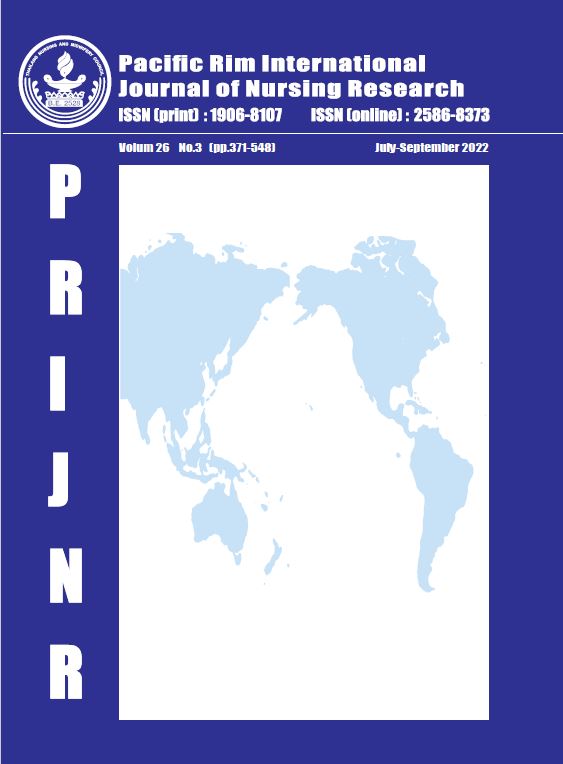Effects of Nurse-Led Fall Prevention Programs for Older Adults: A Systematic Review
Keywords:
Education, Fall Injury, Fall Prevention, Fall Rates, Nurse-led, Older Adults, Literature ReviewAbstract
Falls among older adults are preventable events and fall prevention programs led by nursing staff are promising and viable programs for preventing falls. This systematic review aimed to gain insight into the effects of nurse-led fall prevention programs for older adults. The Preferred Reporting Items for Systemic Reviews and Meta-Analysis was used as a guideline in reporting this literature search conducted through CINAHL, MEDLINE, Eric, Science Direct, and Google Scholar databases. The Johns Hopkins Nursing Evidence-Based Practice was used to determine the level of evidence and quality rating of the articles, while data extraction was done by a matrix review method.
The review included six randomized controlled trials, two non-randomized controlled trials, and three quasi-experimental designs. Six studies directed their education component of the intervention on the nursing staff, while three focused on the older participants. Nurses’ roles were patient assessment, patient education, administration of exercise programs, and follow-up post interventions. Fall rates and fall incidents were reduced in five studies, while three studies changed patients’ behavior. Fall prevention programs with education components specific for older adults and nursing staff resulted in positive outcomes. Nursing staff make a significant contribution to improving patients’ outcomes, and a fall prevention program that focuses on reducing injurious fall rates and enhancing participants’ behavior could maximize its effects.
References
Montalvo I. The National Database of Nursing Quality Indicators (NDNQI). Online J Issues Nurs. 2007;12(3):(3). doi: 10.3912/OJIN.Vol12No03Man02.
Heslop L, Lu S. Nursing-sensitive indicators: a concept analysis. J Adv Nurs. 2014;70(11):2469-82. https://doi.org/10.1111/jan.12503
Centers for Disease Control and Prevention. Older adults and fall data. Available from: https://www.cdc.gov/falls/facts.html
World Health Organization. Falls. [cited 2021 Apr 26]. Available from: https://www.who.int/news-room/factsheets/detail/falls. Accessed January 15th 2022
Trujillo AJ, Hyder AA, Steinhardt LC. Cognitive functioning and the probability of falls among seniors in Havana, Cuba. Int J Aging Hum Dev. 2011;73(2):175-94. doi: 10.2190/AG.73.2.d.
Van Loon IN, Joosten H, Iyasere O, Johansson L, Hamaker ME, Brown EA. The prevalence and impact of falls in elderly dialysis patients: frail elderly patient outcomes on dialysis (FEPOD) study. Arch Gerontol Geriatr. 2019;83:285-91. https://doi.org/10.1016/j.archger.2019.05.015
Fujita N, Sakurai A, Miyamoto A, et al. Stride length of elderly patients with lumbar spinal stenosis: multi-center study using the Two-Step test. J Orthop Sci. 2019;24(5): 787-92. https://doi.org/10.1016/j.jos.2019.01.006
Carrasco C, Tomas‐Carus P, Bravo J, Pereira C, Mendes F. Understanding fall risk factors in community‐dwelling older adults: a cross‐sectional study. Int J Older People Nurs. 2020;15(1):e12294. doi: 10.1111/opn.12294.
Perez-Ros P, Martinez-Arnau FM, Malafarina V, Tarazona-Santabalbina FJ. A one-year proprioceptive exercise programme reduces the incidence of falls in communitydwelling elderly people: a before-after non-randomised intervention study. Maturitas. 2016;94:155-60.
Bhasin S, Gill TM, Reuben DB, et al. A randomized trial of a multifactorial strategy to prevent serious fall injuries. N Engl J Med. 2020;383(2):129-40. https://doi.org/10.1056/NEJMoa2002183
Wilson DS, Montie M, Conlon P, Reynolds M, Ripley R, Titler MG. Nurses’ perceptions of implementing fall prevention interventions to mitigate patient-specific fall risk factors. West J Nurs Res. 2016;38(8):1012-34. https://doi.org/10.1177/0193945916644995
Lee SH, Yu S. Effectiveness of multifactorial interventions in preventing falls among older adults in the community: a systematic review and meta-analysis. Int J Nurs Stud. 2020;106. https://doi.org/10.1016/j.ijnurstu.2020. 103564
Ong MF, Soh KL, Saimon R, Wai MW, Mortell M, Soh KG. Fall prevention education to reduce fall risk among community‐dwelling older persons: a systematic review. J. Nurs. Manag. 2021;29(8):2674-88. https://doi.org/10.1111/jonm.13434
Dykes PC, Carroll DL, Hurley AC, Benoit A, Middleton B. Why do patients in acute care hospitals fall? Can falls be prevented? J Nurs Adm. 2009;39(6):299-304. https://doi.org/10.1097/NNA.0b013e3181a7788a
Yasan C, Burton T, Tracey M. Nurses’ documentation of falls prevention in a patient-centered care plan in a medical ward. Aust J Adv Nurs. 2020;37(2):19-24.
Chan E-Y, Samsudin SA, Lim YJ. Older patients’ perception of engagement in functional self-care during hospitalization: a qualitative study. Geriatr Nurs. 2020;41(3):297-304. https://doi.org/10.1016/j.gerinurse.2019.11.009
Wong MMC, Pang PF. Factors associated with falls in psychogeriatric inpatients and comparison of two fall risk assessment tools. East Asian Arch Psychiatry. 2019;29(1):10-4. https://doi.org/10.12809/eaap1774
Glogovsky D. How can policy change guide nursing practice to reduce in-patient falls? Nurs. 2017;47(12):63-7. https://doi.org/10.1097/01.NURSE.0000526903.22874.65
Agency for Healthcare Research and Quality. Preventing falls in hospitals. 2021 March. [cited 2022 Jan 15]. Available from: https://www.ahrq.gov/patient-safety/settings/hospital/fall-prevention/ toolkit/index.html.
Lee D-CA, Pritchard E, McDermott F, Haines TP. Falls prevention education for older adults during and after hospitalization: a systematic review and meta-analysis.Health Educ J. 2014;73(5):530-44. http://dx.doi.org/10.1177/0017896913499266
Montero-Odasso MM, Kamkar N, Pieruccini-Faria F, et al. Evaluation of clinical practice guidelines on fall prevention and management for older adults: a systematic review. JAMA Netw. 2021;4(12): e2138911. https://doi.org/10.1001/jamanetworkopen. 2021.3891
Morello RT, Barker AL, Ayton DR, et al. Implementation fidelity of a nurse-led falls prevention program in acute hospitals during the 6-PACK trial. BMC Health Serv. Res.2017;17:1-10. https://doi.org/10.1186/s12913-017-2315-z
Thiamwong L, Suwanno J. Effects of simple balance training on balance performance and fear of falling in rural older adults. Int J Gerontol. 2014;8(3):143-6. https://doi.org/10.1016/j.ijge.2013.08.011
Moher D, Liberati A, Tetzlaff J, Altman DG. Preferred reporting items for systematic reviews and meta-analyses:the PRISMA statement. PLoS Med. 2009;6(7):e1000097.https://doi.org/10.1371/journal.pmed.1000097
JHNEBP. Johns Hopkins nursing evidence-based practice Available from: https://www.mghpcs.org/eed/ebp/Assets/documents/pdf/2017_Appendix%20D_Evidence%20Level%20and%20Quality%20Guide.pdf
Goldman KD, Schmalz KJ. The matrix method of literature reviews. Health Promot Pract. 2004;5(1):5-7. https://doi.org/10.1177/1524839903258885
Ye P, Liu Y, Zhang J, et al. Falls prevention interventions for community-dwelling older people living in mainland China: a narrative systematic review. BMC Health Serv Res. 2020;20(1):808. https://doi.org/10. 1186/s12913- 020-05645-0
Dorresteijn TAC, Rixt Zijlstra GA, Ambergen AW, Delbaere K, Vlaeyen JWS, Kempen GIJM. Effectiveness of a home-based cognitive-behavioral program to manage concerns about falls in community-dwelling, frail older people: results of a randomized controlled trial. BMC Geriatr. 2016; 16:1-11.https://doi.org/10.1186/s12877-015-0177-y
Gouveia BR, Gonçalves Jardim H, Martins MM, et al. An evaluation of a nurse-led rehabilitation programme (the ProBalance Programme) to improve balance and reduce fall risk of community-dwelling older people: a randomised controlled trial. Int J Nurs Stud. 2016;56:1-8. https://
doi.org/10.1016/j.ijnurstu.2015.12.004
Guerra FVG, Moreira RP, de Oliveira Ferreira G, et al. Effectiveness of the fall prevention intervention in older adults with arterial hypertension: randomized clinical trial. J Geriatr Nurs. 2021;42(1):27-32. https://doi.org/10.1016/j.gerinurse.2020.11.002
Ward JA, Harden M, Gibson RE, et al. A cluster randomised controlled trial to prevent injury due to falls in a residential aged care population. Med J Aust. 2010;192(6):319-22.
Chidume T. Promoting older adult fall prevention education and awareness in a community setting: a nurse-led intervention. Appl Nurs Res. 2021;57:151392. https://doi.org/10.1016/j.apnr.2020.151392
Montejano-Lozoya R, Miguel-Montoya I, Gea-Caballero V, Mármol-López MI, Ruíz-Hontangas A, Ortí-Lucas R. Impact of nurses’ intervention in the prevention of falls in hospitalized patients. Int J Environ Res. 2020;1717):6048. https://doi.org/10.3390/ijerph17176048
Uymaz PE, Nahcivan NO. Evaluation of a nurse-led fall prevention education program in Turkish nursing home residents. Educ Gerontol. 2016;42(5):299-309. https://doi.org/10.1080/03601277.2015.1109403
Dykes PC, Adelman JS, Alfieri L, et al. The Fall TIPS (Tailoring Interventions for Patient Safety) Program: a collaboration to end the persistent problem of patient falls. nurse lead. 2019;17(4):365-70. https://doi.org/10.1016/j.mnl.2018.11.006
Downloads
Published
How to Cite
Issue
Section
License
Copyright (c) 2022 Pacific Rim International Journal of Nursing Research

This work is licensed under a Creative Commons Attribution-NonCommercial-NoDerivatives 4.0 International License.
Copyright: The Pacific Rim International Journal of Nursing Research, Thailand Nursing & Midwifery Council has exclusive rights to publish, reproduce and distribute the manuscript and all contents therein.








.png)



